
Carlo Francesco Bizzaccheri (13 April 1655 Rome - 11 February 1721 Rome) [1] was an Italian architect. He worked in a Baroque and early Rococo style. [2]

Carlo Francesco Bizzaccheri (13 April 1655 Rome - 11 February 1721 Rome) [1] was an Italian architect. He worked in a Baroque and early Rococo style. [2]
Bizzaccheri trained under the architect Carlo Fontana and possibly also under Carlo Rainaldi. In 1684 he became a member of the Virtuosi al Pantheon, 1712 its "Reggente". He was also a member of the Accademia di San Luca from 1697. [1] [2]
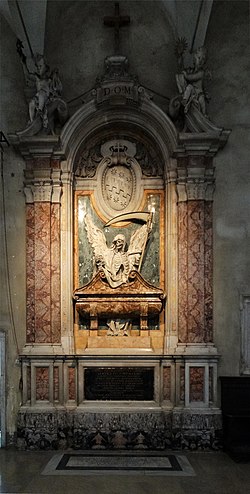
As house architect of prince Giovanni Battista Pamphili Aldobrandini, he built the entrance gate and garden wall of the Villa Aldobrandini in Frascati, accomplished in 1693. [1] [3] He also designed the tomb monument erected by the prince from 1705–07 to his ancestor Cardinal Cinzio Aldobrandini in San Pietro in Vincoli. The sculpture of a winged skeleton and a pair of putti on this monument are by Pierre Le Gros the Younger. [4]
From 1695 he succeeded Giovanni Antonio de' Rossi as architect of the Monte di Pietà in Rome and finished the work on its chapel by 1700 where the dome is decorated to his design. 1700-02 he added the chapel's vestibule.
From 1709-12 [1] Bizzaccheri was the architect of the Palazzo di San Luigi dei Francesi in Rome [5] and from 1712-19 he worked for the Tribunale delle Strade. He was also until 1715 the architect for the cathedral of Orte, a town where also extended the palace of Cardinal Nuzzi.
Bizzaccheri was never assigned any major tasks but nevertheless played an important role in the transformation of the borrominesque vocabulary into the language of Roman rococo. This is exemplified by the facade of Sant’Isidoro a Capo le Case, his most distinguished work, which he constructed from 1704-05 using the extant staircase and portico. He was very much at the forefront of stylistic change and anticipated later tastes as is demonstrated by his completion of the Cappella di San Nicola di Bari, financed by Paolo Girolamo della Torre, in Santa Maria Maddalena. The chapel was begun by Mattia de Rossi in 1690 and finished by Bizzaccheri from 1694–96 in tones that would determine the colour scheme of the rest of the church in the mid-18th century. [1]

Filippo Juvarra was an Italian architect, scenographer, engraver and goldsmith. He was active in a late-Baroque architecture style, working primarily in Italy, Spain, and Portugal.

Girolamo Rainaldi was an Italian architect who worked mainly in a conservative Mannerist style, often with collaborating architects. He was a successful competitor of Bernini. His son, Carlo Rainaldi, became an even more notable, more fully Baroque architect.

San Pietro in Vincoli is a Roman Catholic titular church and minor basilica in Rome, Italy, best known for being the home of Michelangelo's statue of Moses, part of the tomb of Pope Julius II. The Titulus S. Petri ad vincula was assigned on 20 November 2010, to Donald Wuerl. The previous Cardinal Priest of the basilica was Pío Laghi, who died on 11 January 2009.
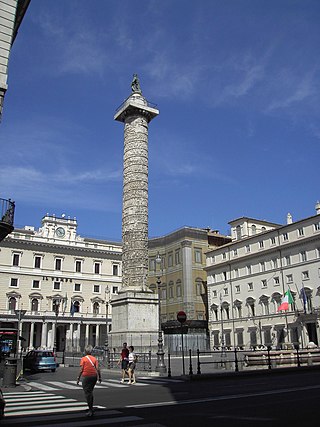
Colonna is the 3rd rione of Rome, identified by the initials R. III and located at the city's historic center in Municipio I. It takes its name from the Column of Marcus Aurelius in the Piazza Colonna, the rione's main square.
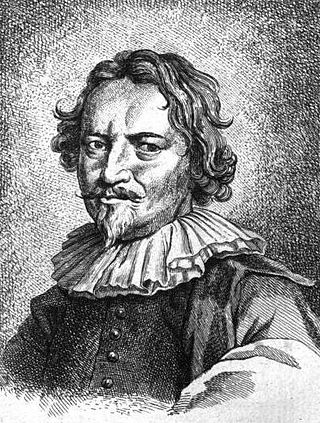
Carlo Fontana (1634/1638–1714) was an Italian architect originating from today's Canton Ticino, who was in part responsible for the classicizing direction taken by Late Baroque Roman architecture.

Giacomo della Porta (1532–1602) was an Italian architect and sculptor, who worked on many important buildings in Rome, including St. Peter's Basilica. He was born at Porlezza, Lombardy and died in Rome.

Gabriele Valvassori was an Italian architect of the late-Baroque period, mainly active in his native city of Rome.

Filippo Raguzzini was an Italian architect best known for a range of buildings constructed during the reign of Benedict XIII.

The Diocese of Frascati is a suburbicarian see of the Holy Roman Church and a diocese of the Catholic Church in Italy, based at Frascati, near Rome. The bishop of Frascati is a Cardinal Bishop; from the Latin name of the area, the bishop has also been called Bishop of Tusculum. Tusculum was destroyed in 1191. The bishopric moved from Tusculum to Frascati, a nearby town which is first mentioned in the pontificate of Pope Leo IV. Until 1962, the Cardinal-Bishop was concurrently the diocesan bishop of the see in addition to any curial duties he possessed. Pope John XXIII removed the Cardinal Bishops from any actual responsibility in their suburbicarian dioceses, and made the title purely honorific.

Ippolito Buzzi (1562–1634) was an Italian sculptor from Viggiù, near Varese, in northernmost Lombardy, a member of a long-established dynasty of painters, sculptors and architects from the town, who passed his mature career in Rome. His personality as a sculptor is somewhat overshadowed by the two kinds of work he is known for: restorations to ancient Roman sculptures, some of them highly improvisatory by modern standards, and sculpture contributed to architectural projects and funeral monuments, where he was one among a team of craftsmen working under the general direction of an architect, like Giacomo della Porta - in projects for Pope Clement VIII, or Flaminio Ponzio - in projects for Pope Paul V - who would provide the designs from which the work was executed, always in consultation with the patron.

Mattia de Rossi was an Italian architect of the Baroque period, active mainly in Rome and surrounding towns.
Giuseppe Sardi was an Italian architect active in Rome. He was born at Sant'Angelo in Vado, Marche which was then part of the Papal States. Known primarily for his church of Santa Maria del Rosario in Marino outside Rome, his name has been linked with the design of the façade of the church of Santa Maria Maddalena in Rome although his involvement with this and with some other building projects remains uncertain. He is not to be confused with the Swiss Italian architect, Giuseppe Sardi (1624–1699), who was active in Venice.
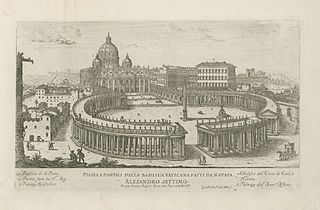
Giovanni Battista Falda was an Italian architect, engraver and artist. He is known for his engravings of both contemporary and antique structures of Rome.

San Girolamo della Carità is a church in Rome, Italy, located near the Palazzo Farnese and Campo de' Fiori.
Francesco Peparelli was an Italian architect during the 17th century. According to a contemporary historian, Giovanni Baglione, between palaces, castles, churches and convents, Peparelli participated in about seventy construction projects but only about thirty can be attributed to him with certainty.

The Santa Maria Maddalena is a Roman Catholic church in Rome, named after Saint Mary Magdalene. It is located on the Via della Maddalena, one of the streets leading from the Piazza della Rotonda in the Campo Marzio area of historic Rome. It is the regional church for the people of Abruzzo.

Benedetto Pamphili was an Italian cardinal, patron of the arts and librettist for many composers.

Francesco Mancini was an Italian painter whose works are known between 1719 and 1756. He was the pupil of Carlo Cignani.
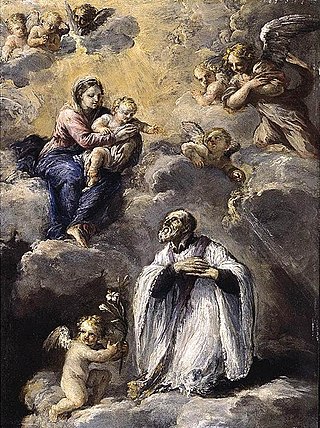
Ludovico Stern was an Italian painter of the Rococo or late-Baroque period, active in Rome. He is known for both large sacred and history paintings, as well as still lives, and portraits.
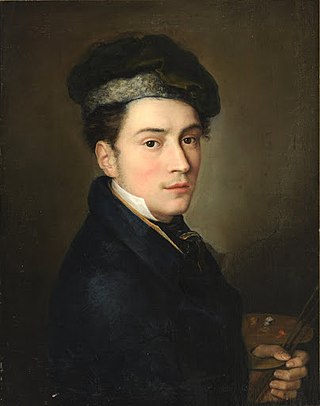
Pietro Gagliardi was an Italian painter and architect, who decorated many churches and palaces in Rome and throughout Italy.